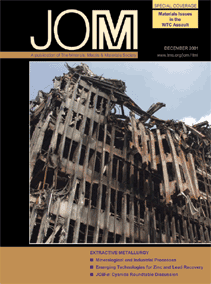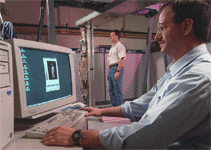 |
NEWS & UPDATE
|
|---|
 |
NEWS & UPDATE
|
|---|
|
|
|
|---|---|
 |
OTHER ARTICLES IN THE WTC
SERIES
Why Did the World Trade Center Collapse? Science, Engineering, and Speculation by Thomas Eagar and Christopher Musso Better Materials Can Reduce the Threat from Terrorism by Toni G. Maréchaux An Initial Microstructural Analysis of A36 Steel from WTC Building 7 by J.R. Barnett, R.R. Biederman, and R.D. Sisson, Jr. |
|
|
|
|
Figure A. A three-dimensional
image of a man is projected onto a computer screen as he passes through
a holographic scanner.
|
 |
|
|
|
Airline passengers who are willing to trade modesty for security may welcome
a 3-D holographic scanner that, essentially, sees through clothing. Developed
by the U.S. Department of Energy’s Pacific Northwest National Laboratory
(PNNL) for the Federal Aviation Administration, the scanner can reveal hidden
items, even non-metallic weapons, on airline passengers. Metal detectors used
now cannot screen for plastic or ceramic weapons.
“To put it simply, the system rapidly scans objects and sends reflected
signals into a high-speed image processing computer,” said Douglas McMakin,
a PNNL engineer who helped develop the technology. “The computer produces
a high-resolution 3-D image from the data.”
The wideband millimeter-wave holographic imaging system, called a Personal
Security Scanner, uses ultrahigh frequency radio waves with relatively large
wavelengths to penetrate clothing and other non-metallic objects (Figure A).
Although x-ray imaging systems might serve the same purpose, such systems
would expose passengers to potentially harmful ionizing radiation. The holographic
imaging system, with wavelengths in the same range as radar and satellite
signals, is harmless, according to the Department of Energy.
The drawback to the system is that the people being scanned appear on a computer
screen in an unclothed image. The PNNL has been working since 1997 to resolve
the potential privacy issue by reprogramming the system to provide a view
only of concealed items, not the person’s physical features.
As the technology exists now, the scanner could take two forms: either cylindrical
or flat. With the cylindrical version, the person to be scanned would step
onto a platform and an extended arm would circle them, providing an image
at all angles. The flat scanner would involve two panels through which a person
would walk to be scanned from both sides.
The aviation administration would like the process to take six seconds, according
to Staci Maloof, a PNNL spokeswoman. Currently, the system requires about
two seconds for the scan and another four to six seconds to process the image,
Maloof said.
The research has been ongoing since 1989, with the FAA paying about $7.5 million
for the work to date, she said. Although funding for the airport security
project ended this spring, the lab, hoping to continue its work, responded
this summer to a request for proposals by the aviation administration for
further study.
Direct questions about this or any other JOM page to jom@tms.org.
| If you would like to comment on the December 2001 issue of JOM, simply complete the JOM on-line critique form | |||||
|---|---|---|---|---|---|
| Search | TMS Document Center | Subscriptions | Other Hypertext Articles | JOM | TMS OnLine |